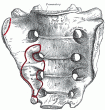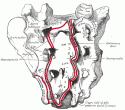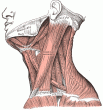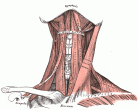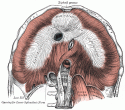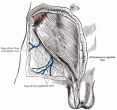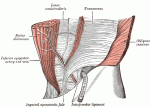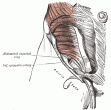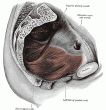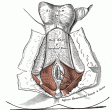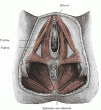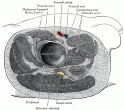Muscle Attachments
Muscle Images
| Region | Muscle | Origin | Insertion | Action |
|---|---|---|---|---|
| Abdomen | External oblique | Lower 8 ribs | Crista iliaca, ligamentum inguinale | Rotates torso |
| Abdomen | Internal oblique | Inguinal ligament, Iliac crest and the Lumbodorsal fascia | Linea alba, Xiphoid process and the inferior ribs. | Compresses abdomen and rotates vertebral column. |
| Abdomen | Transversus abdominis | Ribs and the iliac crest | Inserts into the pubic tubercle via the conjoint tendon, also known as the falx inguinalis | Compress the ribs and viscera, providing thoracic and pelvic stability |
| Abdomen | Rectus abdominis | Pubis | Costal cartilages of ribs 5-7, xiphoid process of sternum | Flexion of trunk/lumbar vertebrae |
| Abdomen | Pyramidalis | Pubic symphysis and pubic crest | Linea alba | Tensing the linea alba |
| Abdomen | Cremaster | Inguinal ligament | Raise and lower the scrotum | |
| Abdomen | Quadratus lumborum | Iliac crest and iliolumbar ligament | Last rib and transverse processes of lumbar vertebrae | Alone, lateral flexion of vertebral column; Together, depression of thoracic rib cage |
| Pelvis | Iliococcygeus | Ischial spine and from the posterior part of the tendinous arch of the pelvic fascia | Coccyx and anococcygeal raphe | Supports the viscera in pelvic cavity |
| Pelvis | Pubococcygeus | Back of the pubis and from the anterior part of the obturator fascia | Coccyx and sacrum | Controls urine flow and contracts during orgasm |
| Pelvis | Puborectalis | Lower part of the pubic symphysis | Inhibit defecation | |
| Pelvis | Coccygeus | Sacrospinous ligament | Closing in the back part of the outlet of the pelvis | |
| Perineum | Sphincter Ani Externus | Anus | Keep the anal canal and anus closed, aids in the expulsion of the feces | |
| Perineum | Sphincter Ani Internus | Anus | Keep the anal canal and anus closed, aids in the expulsion of the feces | |
| Perineum | Transversus perinei superficialis | Anterior part of ischial tuberosity | Central point of perineum | Fixation of central tendon of perineum, support of pelvic floor |
| Perineum | Bulbospongiosus | Median raphé | In males, empties the urethra; in females, clenches the vagina | |
| Perineum | Ischiocavernosus | Median raphé | Assists the bulbospongiosus muscle | |
| Perineum | Transversus perinei profundus | Inferior rami of the ischium | Its fellow of the opposite side | Fixation of central tendon of perineum, support of pelvic floor, expulsion of semen in male and last drops of urine in both sexes |
| Perineum | Sphincter urethrae membranaceae | Junction of the inferior rami [disambiguation needed] of the pubis and ischium to the extent of 1.25 to 2 cm., and from the neighboring fasciæ | Its fellow of the opposite side | Constricts urethra, maintain urinary continence |
| Chest | Intercostales External | Rib - inferior border | Rib - superior border | Inhalation |
| Chest | Intercostales Internal | Rib - inferior border | Rib - superior border | Hold ribs steady |
| Chest | Intercostales Innermost | Rib - inferior border | Rib - superior border | Hold ribs steady |
| Chest | Subcostales | Inner surface of one rib | Inner surface of the second or third rib above, near its angle | Hold ribs steady |
| Chest | Transversus thoracis | Costal cartilages of last 3-4 ribs, body of sternum, xiphoid process | Ribs/costal cartilages 2-6 | Depresses ribs |
| Chest | Levatores costarum | Transverse processes of C7 to T12 vertebrae | Superior surfaces of the ribs immediately inferior to the preceding vertebrae | Assists in elevation of the thoracic rib cage |
| Chest | Serratus posterior inferior | Vertebrae T11 - L3 | The inferior borders of the 9th through 12th ribs | Depress the lower ribs, aiding in expiration |
| Chest | Serratus posterior superior | Nuchal ligament (or ligamentum nuchae) and the spinous processes of the vertebrae C7 through T3 | The upper borders of the 2nd through 5th ribs | Elevate the ribs which aids in inspiration |
| Chest | Diaphragm | Respiration | ||
| Neck | Platysma | Inferior clavicle and fascia of chest | Mandible | Draws the corners of the mouth inferiorly and widens it (as in expressions of sadness and fright). Also draws the skin of the neck superiorly when teeth are clenched |
| Neck | Sternocleidomastoid | Manubrium sterni, medial portion of the clavicle | Mastoid process of the temporal bone, superior nuchal line | Acting alone, tilts head to its own side and rotates it so the face is turned towards the opposite side.Acting together, flexes the neck, raises the sternum and assists in forced inspiration. || |
| Neck | Digastric | Anterior belly - digastric fossa (mandible); posterior belly - mastoid process of temporal bone | Intermediate tendon (hyoid bone) | Opens the jaw when the masseter and the temporalis are relaxed. |
| Neck | Stylohyoid | Styloid process (temporal) | Greater cornu of hyoid bone | Elevate the hyoid during swallowing |
| Neck | Mylohyoid | Mylohyoid line (mandible) | Median raphé [disambiguation needed] | Raises oral cavity floor, elevates hyoid, depresses mandible |
| Neck | Geniohyoid | Symphysis menti | Hyoid bone | Carry hyoid bone and the tongue upward during deglutition |
| Neck | Sternohyoid | Manubrium of sternum | Hyoid bone | Depress hyoid bone |
| Neck | Sternothyroid | Manubrium | Thyroid cartilage | Elevates larynx, may slightly depress hyoid bone |
| Neck | Thyrohyoid | Thyroid cartilage | Hyoid bone | Depress hyoid bone |
| Neck | Omohyoid | Upper border of the scapula | Hyoid bone | Depresses the larynx and hyoid bone. Carries hyoid bone backward and to the side |
| Neck | Longus colli | Transverse processes of C-3 - C-6 | Inferior surface of the occipital bone | Flexes the neck and head |
| Neck | Longus capitis | Anterior tubercles of the transverse processes of the third, fourth, fifth, and sixth cervical vertebrae | Basilar part of the occipital bone | Flexion of neck at atlanto-occipital joint |
| Neck | Rectus capitis anterior | Atlas | Occipital bone | Flexion of neck at atlanto-occipital joint |
| Neck | Rectus capitis lateralis | Upper surface of the transverse process of the atlas | Under surface of the jugular process of the occipital bone | Sidebend at atlanto-occipital joint |
| Neck | Scalenus Anterior | C3-C6 | First rib | Elevate 1st rib, rotate the neck to the opposite side |
| Neck | Scalenus Medius | C2-C6 | First rib | Elevate 1st rib, rotate the neck to the opposite side |
| Neck | Scalenus Posterior | Transverse processes of C4 - C6 | 2nd rib | Elevate 2nd rib, tilt the neck to the same side |
| Neck | Rectus Capitis Posterior Major | Spinous process of the axis (C2) | Inferior nucheal line of the occipital bone | Extend and rotate the atlanto-occipital joint |
| Neck | Rectus Capitis Posterior Minor | The tubercle on the posterior arch of the atlas | The medial part of the inferior nuchal line of the occipital bone and the surface between it and the foramen magnum | Extends the head at the neck, but is now considered to be more of a sensory organ than a muscle |
| Neck | Obliquus Capitis Inferior | Spinous process of the axis | Lateral mass of atlas | Rotation of the head and first cervical vertebra |
| Neck | Obliquus Capitis Superior | Lateral mass of atlas | Lateral half of the inferior nuchal line | Extend the head and flex the head to the ipsilateral side |
| Back | Splenius capitis | Ligamentum nuchae, spinous process of C7-T6 | Mastoid process of temporal and occipital bone | Extend, rotate, and laterally flex the head |
| Back | Splenius cervicis | Spinous processes of T3-T6 | Transverse processes of C1, C2, C3 | Bilaterally: Extend the head & neck, Unilaterally: Lateral flexion to the same side, Rotation to the same side |
| Back | Erector spinae | On the spines of the last four thoracic vertebræ | Both the spines of the most cranial thoracic vertebrae and the cervical vertebrae | Extends the vertebral column |
| Back | Iliocostalis | Sacrum/Illiac Crest/Spinous Processes of lower lumbar/thoracic vertebrae | Ribs | Laterally: Flex the head and neck to the same side. Bilaterally: Extend the vertebral column |
| Back | Longissimus | Transverse process | Transverse process | Laterally: Flex the head and neck to the same side. Bilaterally: Extend the vertebral column. |
| Back | Spinalis | Spinous process | Spinous process | Laterally: Flex the head and neck to the same side. Bilaterally: Extend the vertebral column. |
| Back | Latissimus dorsi | Spinous processes of thoracic T6-T12, thoracolumbar fascia, iliac crest and inferior 3 or 4 ribs | Floor of intertubercular groove of the humerus | Adducts and extends the shoulder |
| Back | Semispinalis dorsi | Transverse processes of the sixth to the tenth thoracic vertebræ | Spinous processes of the upper four thoracic and lower two cervical vertebrae | Laterally: Flex the head and neck to the same side. Bilaterally: Extend the vertebral column. |
| Back | Semispinalis cervicis | Transverse processes of the upper five or six thoracic vertebræ | Cervical spinous processes, from the axis to the fifth | Laterally: Flex the head and neck to the same side. Bilaterally: Extend the vertebral column. |
| Back | Semispinalis capitis | Transversal process of lower cervical and higher thoracal columna | Area between superior and inferior nuchal line | Extend the head |
| Back | Multifidus | Sacrum, Erector spinae Aponeurosis, PSIS, and Iliac crest | Spinous process | Stabilizes vertebrae in local movements of vertebral column |
| Back | Rotatores | Transverse process | Spinous process | Stabilizes vertebrae in local movements of vertebral column |
| Back | Interspinales | Spinous process | Spinous process | Extension, flexion and rotation of vertebral column. |
| Back | Intertransversarii | Transverse process | Transverse process above | Lateral flexion of trunk |



